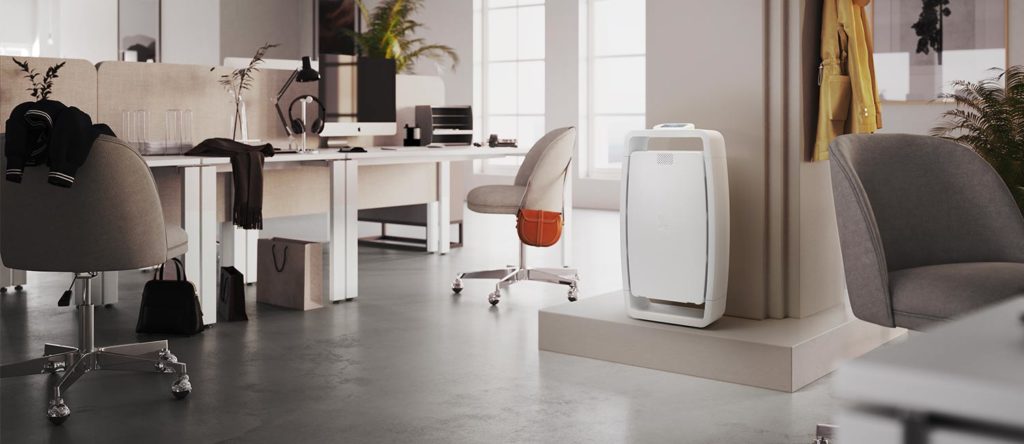25/07/2024
Japan on red alert for streptococcal toxic shock syndrome

24 February 2021
Indoor air quality is an issue that is more and more concerning everyone of us. The link between what we breathe and its consequences on our health is now a tangible reality for each and every one of us.
How then monitoring and improving this IAQ inside offices and work spaces, where we spend on average a third part of our day?
We are breathing an average quantity of 15,000 litres of air per day, and spend 90% of our time inside, among the office, transports and home. According to the World Health Organization, indoor air is 8 times more polluted than outdoors.
This can be explained by a lack of aeration or regular ventilation, which lead to a higher concentration of pollutants.
According to a study conducted by the Purdue University in 2019, this rate would be much higher for office employees working in open-plan work spaces. They would be breathing an air 10 to 20 times more polluted indoors than outdoor.
 Employees working in open-plan work spaces are confronted to a higher indoor air pollution
Employees working in open-plan work spaces are confronted to a higher indoor air pollution
The R. 4222-6 article of the French Labour Code enforces the control of indoor air quality in offices, with the following measures:
The article divides the premises into three categories, whose measures differ accordingly:
Offices and open-plan work spaces are considered as premises with non-specific pollution. The law enforces the companies to be equipped with a manual or mechanical ventilation system, in permanent use.
As for dust, the French law establishes a maximum inhalation rate of 10mg/m3/person, for an average working day of 8 hours. This rate is of 5 mg/m3 for respirable dust fractions (that can enter the pulmonary tract and reach alveoli).
What’s more, organisms such as WHO, the ANSES (The French Agency for Food, Environmental and Occupational Health & Safety) or the French Public Health Council give recommendations (called guidelines), which establish rates by pollutant type. Finally, during this current period of sanitary crisis (Covid-19), a national protocol was established in September 2020, regarding the return to the work place, and imposes additional instructions about air quality within the company.
Air pollutants can be divided into three categories: particles, Volatile Organic Compounds (VOCs) and microorganisms (viruses and bacteria). These categories are explained in further detail in this article.
In a company, these are the pollutants most likely to be found:
Furniture and office equipment are a source of VOC emission too, especially printer inks (hydrocarbon), or combustion devices (heating system, etc.). Finally, employees themselves can release some VOCs, by their living habits, such as wearing perfume, or using cosmetic or care products.
If smoking areas are proximate to the doors and windows, smoke particles can easily be found into the ambient air, just like the use of home fragrances can cause higher air pollution as well.
 Employees themselves are vectors of certain air pollutants
Employees themselves are vectors of certain air pollutants
Finally, outdoor air can bring some other sources of pollution, because it enters the building, when opening windows for example. According to the environment in which are located the company premises, outdoor air can be more or less loaded with pollutants. Indeed, it will be much more polluted if the premises are located next to an industrial or agricultural area, an airport, main traffic roads, construction sites, etc.
The issue of coworking and open-plan work spaces, or meeting rooms and other shared areas is as follows: the higher the human concentration (number of people), the higher air pollution and CO2 rates too.
To know the IAQ index in real time conditions, especially the CO2 carbon dioxide and/or pollutants concentration within a room, and thus ensure that you are respecting the rates, some measuring instruments exist.
DISCOVER natéosanté’s measuring instruments AND CO2 sensorPoor air quality in offices and open-plan work spaces will cause issues, both for the employees’ health and for the companies, from an economical point of view.
An air loaded with pollutants can cause many risks on the employees’ health. The most frequent ones will be a lack of concentration, fatigue, headaches, but also a higher dryness on the mucous membranes, or could cause irritations on the respiratory tract.
 Poor air quality will cause a lack of concentration and headaches
Poor air quality will cause a lack of concentration and headaches
Moreover, for the people who are sensitive to this subject, poor indoor air quality could end up causing allergic, respiratory, ocular or rheumatologic pathologies.
Aeration (also called manual ventilation), has numerous benefits. It renews the air and dilutes the concentration of certain pollutants, especially the chemical ones, within indoor air.
However, aerating to renew the air is not always possible in a company, because some offices have no windows, or these are locked, in order for the companies to respect technical, economical or safety standards. It is especially the case for office buildings.
Concerning aeration means, most of the buildings are equipped with a controlled mechanical ventilation system, with single or double flow. This one aims at removing indoor air to release it outdoors, while renewing the air of the room with air coming from outside.
The main benefits of ventilation are the dilution of pollutants, the reduction of the humidity rate, and the decrease of the CO2 concentration.
 Ventilation systems in companies have some advantages but also a few drawbacks
Ventilation systems in companies have some advantages but also a few drawbacks
However, there are some drawbacks in the action of mechanical ventilation, that need to be pointed out:
As for heating and/or cooling systems, which provide thermal comfort to the employees, they can however create some issues regarding air quality, and foster the increase of the pollution rate inside work spaces.
The cooling system can also bring more pollutant volatility (pollen, dust). In addition, cool air makes viral particles more persistent.
To sum up, a good ventilation system is essential in the work place, because it reduces the CO2 rate in indoor air and dilutes the pollutants. However, it is not efficient enough to remove them. This is why air purification acts as an additional solution. It completes the “aerating, ventilating, purifying” triptych.
BUSINESSES: WHY BUY A PROFESSIONAL AIR PURFIER?The professional air purifier resolves the different issues caused by ventilation. When installing the controlled mechanical ventilation system, this one is set up to renew the air according to the number of persons who occupy the room in general, in order to maintain a rate which complies with the regulation.
However, this number can easily increase and exceed the capacity which has initially been planned, especially in meeting rooms and other frequented areas (such as reception, break room, canteen, etc.).
The action of the ventilation system will thus be insufficient, unlike an indoor air purifier such as EOLIS Air Manager. It automatically adapts its operating speed according to the indoor air pollution degree, regardless of the number of people there is inside the same room.
In addition, thanks to its smart sensors, EOLIS Air Manager measures and displays on the screen the levels of VOC and PM2.5 microparticles, allowing you to monitor air quality in real time.
 The touchscreen of EOLIS Air Manager displays the level of indoor air pollution in real time conditions
MORE INFORMATION ON EOLIS AIR MANAGER
The touchscreen of EOLIS Air Manager displays the level of indoor air pollution in real time conditions
MORE INFORMATION ON EOLIS AIR MANAGER
A professional air purifier will not have any impact on the temperature nor the humidity rate of the room, unlike heating and cooling systems. When drying the air, these ones can cause discomfort for people (dryness of mucous and eyes).
For employees, working in an environment where the air is pure participates in improving their quality of work life (QWL), as it has a direct impact on their comfort and wellbeing inside the company. Indeed, they will benefit from higher concentration and will be more performant, what will reduce sick leave.
The REHVA study, Guidebook: Indoor Climate and Productivity in Offices states short-term sick leaves decrease by 10% when there are half as much pollutants in the air. Moreover, a better air quality leads to an 11% increase of the productivity rate, according to the French Ministry of Health and Solidarity.
 EOLIS Air Manager discreetly fits into the company premises
EOLIS Air Manager discreetly fits into the company premises
Equipping its premises with professional air purifiers can also be used in your CSR approach. Healthy air indeed is a key lever for employee satisfaction.
EOLIS Air Manager completely responds to this strategy, has it is eco-designed, 100% made in France and its safety has been proven.
MORE INFORMATION ON NATÉOSANTÉ’S APPROACH ABOUT SUSTAINABLE DEVELOPMENTSince the beginning of the Covid-19 pandemic, the issues related to air quality have taken a new turn: IAQ diagnostic, IAQ monitoring… becoming a major employees’ preoccupation in the context of the continuity of the economic activity.
Some professions require to be physically present in the work place, because working from home is not always possible, or sometimes, it is not at all. This can particularly be true for the production, technical, administration, sales, accountability, or management and executive departments.
 Respecting barrier measures is essential to limit the propagation of the SARS-CoV-2 virus
Respecting barrier measures is essential to limit the propagation of the SARS-CoV-2 virus
The Institut Pasteur conducted a study on the major places of infection with SARS-CoV-2. It reveals that among infections outside households (that is to say 65% of infections where the person considered to be the source was known), 29% are happening on the work place. The study also states “shared offices were also a major cause of infections in the work place”.
A professional air purifier will protect your employees’ health, as well as your potential visitors (partners, suppliers, clients, hiring interviews).
EOLIS Air Manager is the only professional air purifier whose efficacy has been tested and proven against coronaviruses, at 99.6%. The device could get these results thanks to its medical-grade HEPA filter, developed to purify the air in any environment. A French independent laboratory carried out the tests.
 EOLIS Air Manager is 99.6% effective against coronaviruses
EOLIS Air Manager is 99.6% effective against coronaviruses
In addition to barrier measures (wearing a mask, applying physical distancing, washing hands regularly), EOLIS Air Manager reduces the virus propagation in the air, by catching and destroying it thanks to its exclusive filtration system.
It thus responds to the employees’ preoccupations, who fear the virus transmission on their work place, but also to bring it back home.
Equipping your premises with EOLIS Air Manager is a long-term investment, that will help you look with higher serenity towards the continuity of your economic activity and your staff returning to the office.
DISCOVER NATÉOSANTÉ’S SOLUTIONS FOR OFFICES AND OPEN-PLAN WORK PLACES